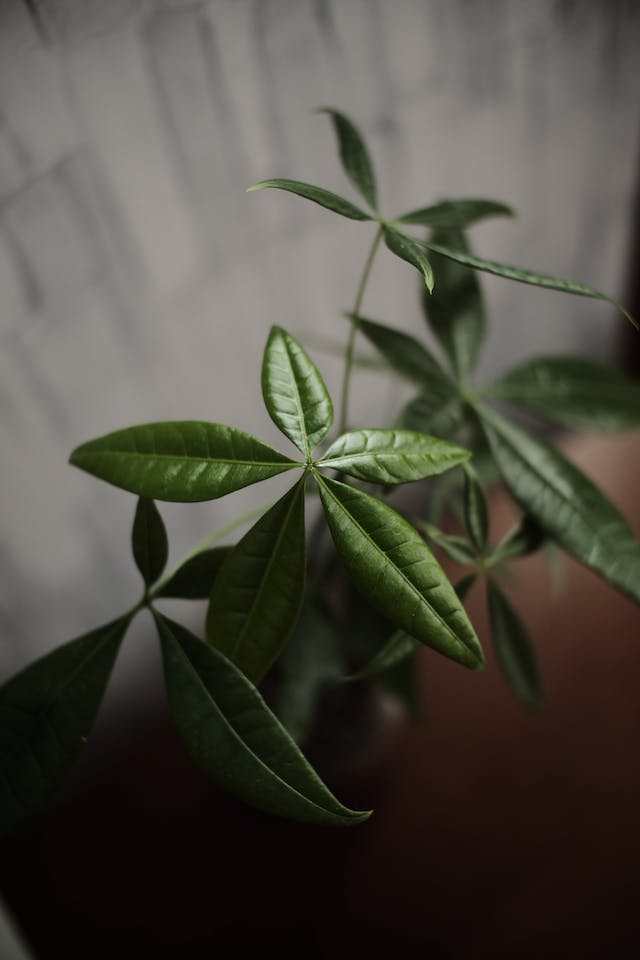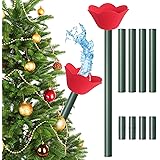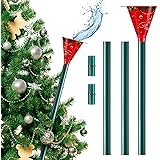Have you noticed mysterious holes in your money tree leaves? Don’t fret! We’ve got the answer you’re looking for. These tiny perforations can be quite disconcerting at first, but fear not – there’s a simple and natural solution. Money trees, also known as Pachira aquatica, are popular houseplants renowned for their resilience and ability to bring good luck and prosperity.
However, like any plant, they can face a few challenges along the way. So, let’s dive into the fascinating world of money tree leaves and uncover the secrets behind those intriguing holes. Get ready for an enlightening journey!
Holes in Money Tree Leaves: What They Indicate and How to Fix Them
The Money Tree (Pachira aquatica) is a popular houseplant known for its unique braided trunk and lush green foliage. However, at times, you may notice small holes or perforations in the leaves of your Money Tree. These holes can be a cause for concern as they may indicate underlying issues that need attention.
In this article, we will explore the possible causes of holes in Money Tree leaves and discuss effective ways to address them.
Possible Causes of Holes in Money Tree Leaves
There are several factors that can contribute to the formation of holes or perforations in Money Tree leaves.
Understanding these causes will help you diagnose the issue and take appropriate measures to rectify it.
1. Insect Infestation
Insect pests can be a common cause of holes in Money Tree leaves. Here are a few pests to watch out for:
- Spider Mites: These tiny arachnids feed on the sap of the leaves, creating small holes and webbing. They can be difficult to spot due to their size.
- Mealybugs: Mealybugs are white, cottony insects that suck sap from plants. Their feeding can result in distorted leaves and noticeable perforations.
- Aphids: These small, soft-bodied insects can cluster on the undersides of leaves, causing damage through their feeding activity.
If you suspect insect infestation, carefully inspect the affected leaves and the plant’s surroundings. Look for signs such as tiny webs, white cottony masses, or clusters of small insects.
Treat the infestation using organic insecticides or natural remedies like neem oil or insecticidal soaps.
2. Fungal or Bacterial Infections
Fungal or bacterial infections can also lead to the development of holes in Money Tree leaves.
These infections typically occur when the plant is exposed to excessive moisture or poor air circulation. Common culprits include:
- Leaf Spot Diseases: Various fungal or bacterial pathogens can cause leaf spots, which may result in the formation of holes as the infected areas deteriorate.
- Anthracnose: Anthracnose is a fungal disease that often affects the tips and edges of leaves, causing necrotic areas and perforations.
- Soft Rot: Soft rot is a bacterial infection that can cause decay and holes in affected leaves.
To prevent and treat fungal or bacterial infections, ensure proper drainage for your Money Tree, avoid over-watering, and maintain good air circulation around the plant.
Remove and destroy any severely affected leaves, and apply appropriate fungicides or bactericides as needed.
3. Physical Damage
Physical damage is another possible cause of holes in Money Tree leaves. Accidental bumps, cuts from sharp objects, or even nibbling by pets can result in visible perforations.
While physical damage is usually easy to identify, it’s important to rule out other potential causes as well.
Read More: About How to Grow and Propagate Money Tree
How to Fix Holes in Money Tree Leaves
Once you have identified the cause of the holes in your Money Tree leaves, you can take appropriate steps to address the issue and promote healthy foliage growth.
1. Insect Control
If the holes are due to insect infestation, follow these steps to control the pests and minimize leaf damage:
- Inspect the entire plant, including the undersides of leaves, for signs of pests.
- Isolate the affected Money Tree from other plants to prevent the infestation from spreading.
- Choose the appropriate organic insecticide or natural remedy based on the identified pests and follow the instructions for application.
- Regularly monitor the plant for any signs of recurring infestation and take swift action if necessary.
2. Fungal and Bacterial Disease Management
To manage fungal or bacterial infections causing holes in Money Tree leaves, take the following measures:
- Improve air circulation around the plant by providing adequate spacing between other plants.
- Avoid overhead watering, as it can create a moist environment that promotes disease development.
- Remove and dispose of severely infected leaves to prevent the spread of pathogens.
- Apply a suitable fungicide or bactericide according to the product instructions.
3. Preventing Physical Damage
To prevent physical damage to your Money Tree leaves, consider the following tips:
- Place your Money Tree in a location away from high traffic areas to reduce the risk of accidental bumps or knocks.
- Keep sharp objects or potential hazards out of reach of pets and children.
- If you have curious pets, consider using a plant stand or hanging the Money Tree out of their reach.
Holes in Money Tree leaves can indicate various underlying issues, including insect infestation, fungal or bacterial infections, or physical damage. By identifying the cause and taking appropriate measures to address it, you can restore the health and beauty of your Money Tree.
Regular monitoring, proper care, and prompt action will help ensure that your Money Tree thrives, providing you with vibrant leaves and a touch of nature indoors.
Read More: About Why Is My Kangaroo Fern Dying
Frequently Asked Questions (FAQs)
Money tree leaves can have holes due to various reasons. Common causes include insect infestations, such as spider mites or aphids, which feed on the leaves and create small holes. Other potential causes could be physical damage, like punctures from sharp objects or accidental tears.
To prevent insect infestations, regularly inspect your money tree for any signs of pests. If you notice any insects, you can wipe the leaves with a mild soapy solution or spray them with neem oil. Additionally, make sure to keep your money tree in a well-ventilated area with good airflow, as this can discourage pests.
Yes, there are some natural remedies you can try. One option is to mix water and dish soap in a spray bottle and apply it to the affected leaves. Alternatively, you can create a homemade insecticidal spray using a mixture of water, garlic, and cayenne pepper. These remedies can help deter insects and protect your money tree leaves.
Overwatering can indirectly lead to holes in money tree leaves. When the soil remains excessively wet for extended periods, it can create a favorable environment for fungus gnats. These tiny insects lay their eggs in the soil, and the larvae feed on the roots, causing stress to the money tree. Eventually, this stress can result in leaf damage, including the formation of holes.
To address holes caused by overwatering, it is crucial to adjust your watering routine. Allow the soil to partially dry before watering again to prevent excessive moisture. You can also consider repotting your money tree in well-draining soil to ensure proper water drainage. Additionally, applying a hydrogen peroxide solution to the soil can help control fungus gnat larvae.
Yes, nutrient deficiencies can contribute to the formation of holes in money tree leaves. A lack of essential nutrients, such as nitrogen, potassium, or magnesium, can weaken the plant’s overall health and make it more susceptible to pests and diseases. It is important to provide proper fertilization and ensure your money tree receives a balanced diet of nutrients.
To maintain the health of your money tree and prevent holes in the leaves, it is recommended to fertilize once every 2-4 weeks during the growing season (spring and summer). Use a balanced liquid fertilizer diluted according to the package instructions. Remember to avoid overfertilizing, as this can lead to salt buildup and further damage the plant.
Pruning can help address holes in money tree leaves caused by physical damage or severe infestations. Use clean, sharp pruning shears to remove affected leaves or damaged sections of the leaf. This promotes new growth and improves the overall appearance of the plant. Remember to sanitize your tools before and after pruning to prevent the spread of diseases.
Final Thoughts
In conclusion, the presence of holes in money tree leaves can be a cause for concern. These holes can indicate various issues such as insect infestation, disease, or improper care. It is important for plant owners to closely observe their money trees and take appropriate measures to address any underlying problems. Regular pruning, proper watering, and providing a suitable environment can help prevent further damage to the leaves.
Additionally, consulting with experts or horticulturists can provide valuable insights and guidance for maintaining the health and vitality of money tree plants. By staying vigilant and proactive, these holes in money tree leaves can be effectively managed and the plant can continue to thrive.
Auto Amazon Links: No products found.
Perfect Plants Christmas Tree Saver 8oz. | Easy Use Xmas Tree Preserver Food | Have Healthy Green Christmas Trees All Holiday Season
$9.97 (as of December 16, 2025 05:22 GMT +00:00 - More info- Product prices and availability are accurate as of the date/time indicated and are subject to change. Any price and availability information displayed on [relevant Amazon Site(s), as applicable] at the time of purchase will apply to the purchase of this product.
FirEver Pure Christmas Tree Food | Preserver Additive & Season Extender for Live Xmas Trees | Keep It Green, Reduce Needle-Drop | Miracle Freshness (8 oz)
$14.99 (as of December 16, 2025 05:22 GMT +00:00 - More info- Product prices and availability are accurate as of the date/time indicated and are subject to change. Any price and availability information displayed on [relevant Amazon Site(s), as applicable] at the time of purchase will apply to the purchase of this product.
Rocky Mountain Goods Christmas Tree Food - 8 oz Tree Preservative - Reduce Needle Drop - Greener Scent - Fir, Pine, Spruce Trees - Extend Tree Life
$9.95 (as of December 16, 2025 05:22 GMT +00:00 - More info- Product prices and availability are accurate as of the date/time indicated and are subject to change. Any price and availability information displayed on [relevant Amazon Site(s), as applicable] at the time of purchase will apply to the purchase of this product.
EZMeetU Christmas Tree Watering Funnel, 47 Inch Flower Shape Adjustable 6 Section Design, Christmas Tree Watering System, Christmas Tree Waterer, Long Funnel Wide Opening Reusable, Plant Watering Tool
$16.99 (as of December 16, 2025 05:22 GMT +00:00 - More info- Product prices and availability are accurate as of the date/time indicated and are subject to change. Any price and availability information displayed on [relevant Amazon Site(s), as applicable] at the time of purchase will apply to the purchase of this product.
VICAMB 39.3 Inch Christmas Tree Watering Funnel,Christmas Tree Watering System Device,Long Tree Watering Funnel Spout for Indoor Outdoor Xmas Tree
$17.99 (as of December 16, 2025 05:22 GMT +00:00 - More info- Product prices and availability are accurate as of the date/time indicated and are subject to change. Any price and availability information displayed on [relevant Amazon Site(s), as applicable] at the time of purchase will apply to the purchase of this product.
Snow Joe Premium Enviro Blend Ice Melt, Green-Coated Deicer Crystals, 50 lb - Safer Melter for Vegetation, Concrete & Metals w/ Anti-Corrosion Calcium Magnesium Acetate
$32.97 (as of December 12, 2025 19:27 GMT +00:00 - More info- Product prices and availability are accurate as of the date/time indicated and are subject to change. Any price and availability information displayed on [relevant Amazon Site(s), as applicable] at the time of purchase will apply to the purchase of this product.
Muddy Mat® Shown on TV Super Absorbent Microfiber Dog Door Mat for Muddy Paws, Non-Slip Washable Pet Rug, Quick Dry Chenille Entryway Carpet, Machine Washable Indoor Outdoor mat, Grey 30"x19"
$24.95 (as of December 12, 2025 19:27 GMT +00:00 - More info- Product prices and availability are accurate as of the date/time indicated and are subject to change. Any price and availability information displayed on [relevant Amazon Site(s), as applicable] at the time of purchase will apply to the purchase of this product.
ivtivfu Rolling Grill Basket, Removable Wooden Handle, 304 Stainless Steel, Nesting BBQ Tools, Smoker Grilling Accessories for Vegetable, Outdoor Cooking Camping, Birthday Gifts for Men Dad Husband
$25.99 (as of December 12, 2025 19:27 GMT +00:00 - More info- Product prices and availability are accurate as of the date/time indicated and are subject to change. Any price and availability information displayed on [relevant Amazon Site(s), as applicable] at the time of purchase will apply to the purchase of this product.
XXXFLOWER Plant Terrarium with Wooden Stand, Air Planter Bulb Glass Vase Metal Swivel Holder Retro Tabletop for Hydroponics Home Garden Office Decoration - 3 Bulb Vase
$18.98 (as of December 12, 2025 19:27 GMT +00:00 - More info- Product prices and availability are accurate as of the date/time indicated and are subject to change. Any price and availability information displayed on [relevant Amazon Site(s), as applicable] at the time of purchase will apply to the purchase of this product.
Zevo Flying Insect Trap Official Refill Cartridges - Fits Both Zevo Trap & MAX Indoor Fly Trap - Authentic Trap+Lock Technology to Catch Gnats, House & Fruit Flys (4 Official Refill Cartridges)
$14.97 (as of December 12, 2025 19:27 GMT +00:00 - More info- Product prices and availability are accurate as of the date/time indicated and are subject to change. Any price and availability information displayed on [relevant Amazon Site(s), as applicable] at the time of purchase will apply to the purchase of this product.











